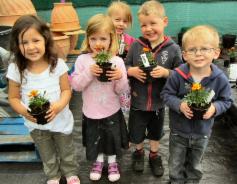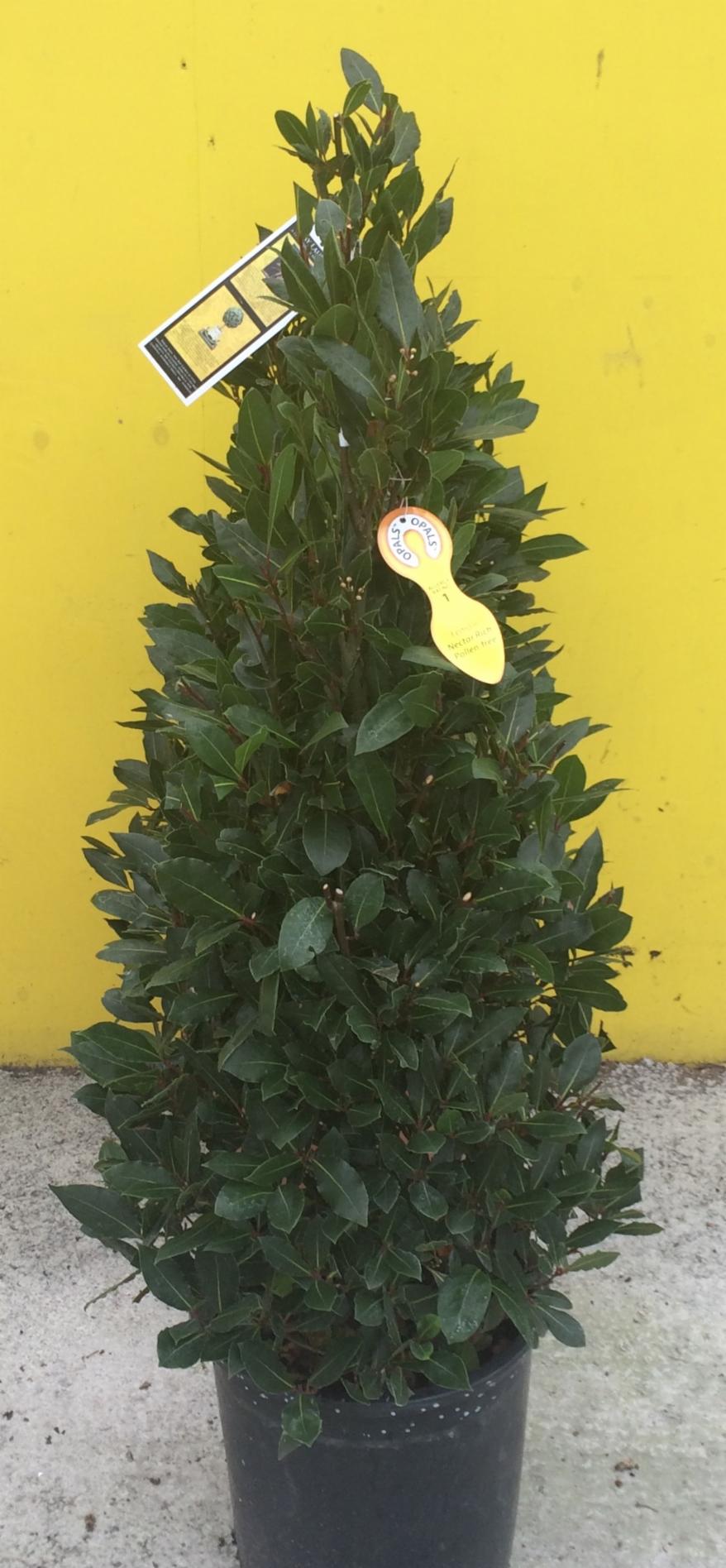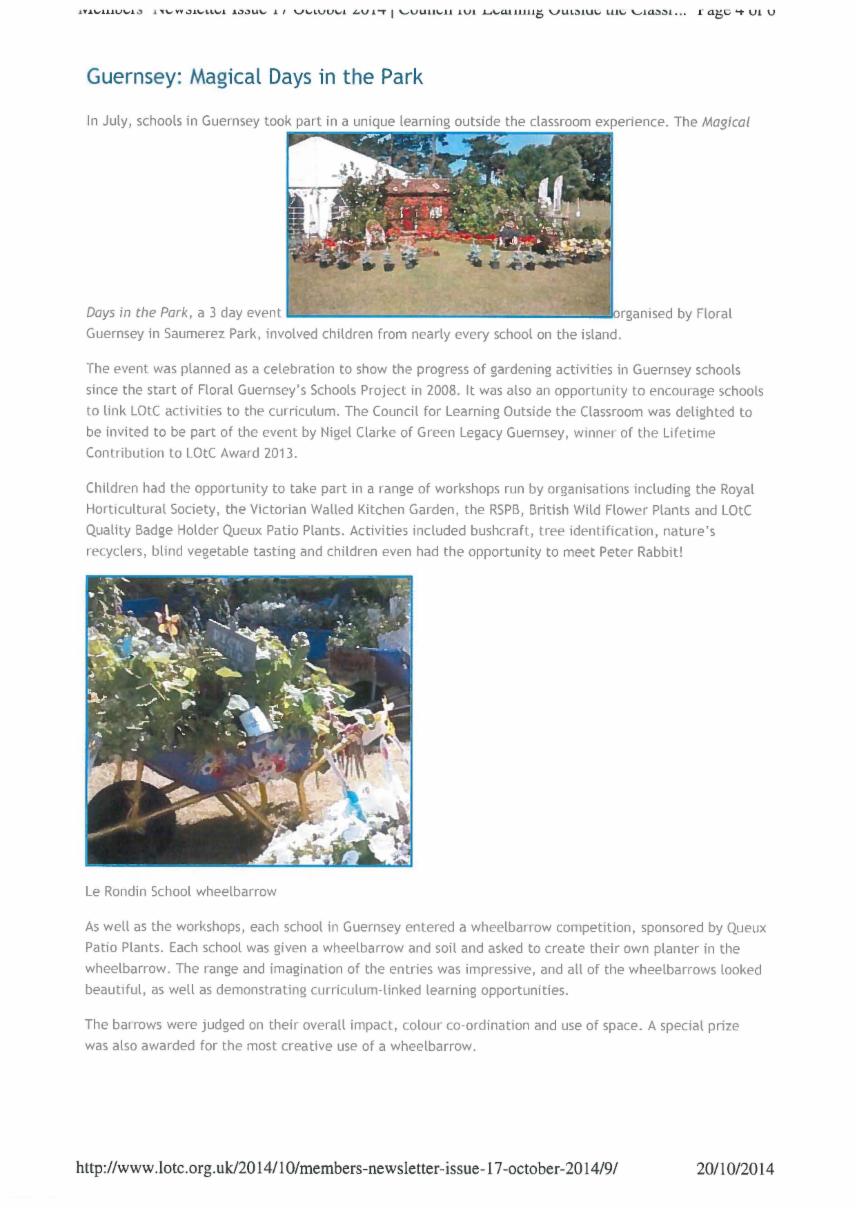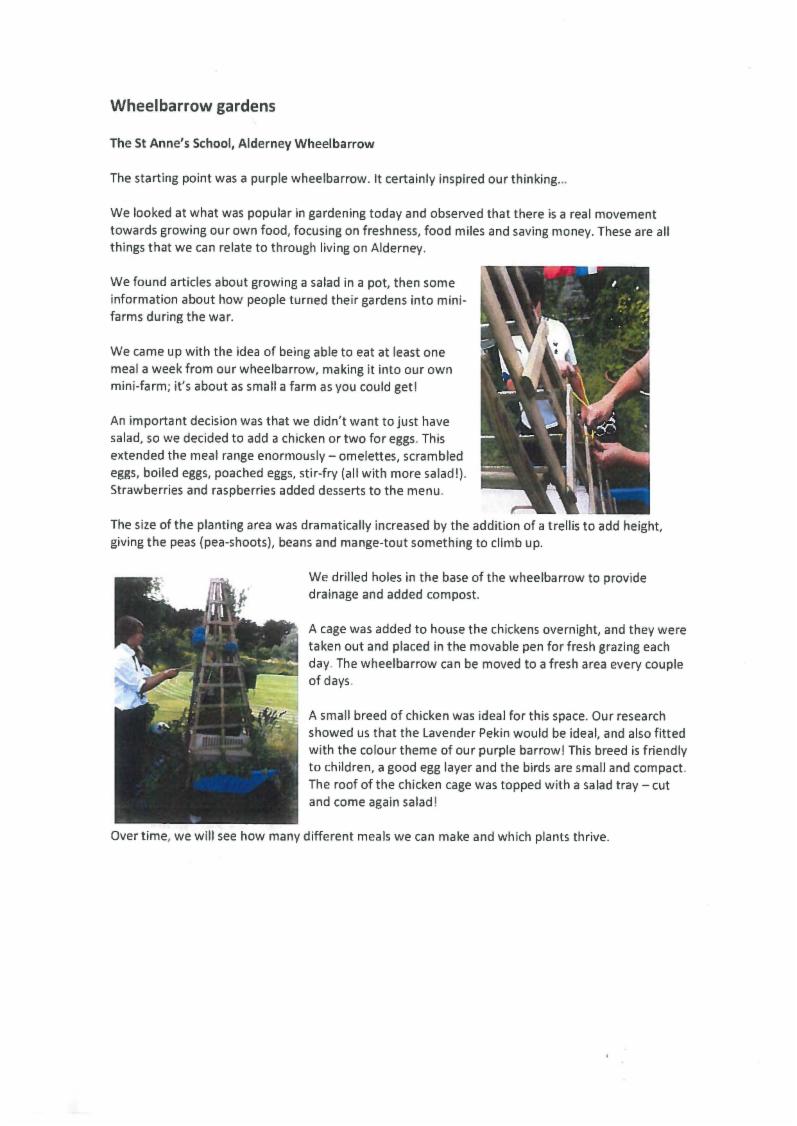EDUCATION - Learning Outside the Classroom (LOtC)
Education is a key objective of Green Legacy Guernsey and Nigel is proud that Queux Plant Centre has been granted the LOtC Quality Badge accreditation by the Council for Learning Outside the Classroom.
The Council for Learning Outside the Classroom, a registered charity, is the national voice for learning outside the classroom. It believes that every young person (0 to 19 years of age) should experience the world beyond the classroom as an essential part of the learning and personal development, whatever their age, ability or circumstances.
"Learning outside the classroom has positive benefits for all groups of young people, including those underachieving or not sufficiently motivated by mainstream provision". Robin Hammerton, HMI, Ofsted.
Workshops held at Queux Plant Centre since its inception in 1988 have taught thousands of adults and children how to sow seeds and to pot plants. These workshops also help children to connect with their natural surroundings through their five senses (sight, hearing, touch, smell, taste).

LOtC accreditation means that Nigel can deliver LOtC 'real world' curriculum teaching workshops to young people in Guernsey www.lotc.org.uk

click badge for details
Organising an LOtC Workshop
Green Legacy Guernsey works and tailors to the schools' needs to fit in with the curriculum requirements and any other specific requirements of the school.
LOtC Workshop Information
Introduction
Thank you for your interest in holding a workshop with us. Green Legacy Guernsey has attained the Learning Outside the Classroom Quality Badge and our workshops are based on the standards set for the national schools curriculum.
Aim of Our Workshop
To offer a tailored programme to your school's curriculum needs. To provide accurate information. To provide activities/experience which meets your school's needs. To provide a safe learning outside the classroom environment. Most importantly, to create an enjoyable and fun learning outside the classroom experience for all.
Workshop Booking Information
Please provide the following details if you would like to book a workshop;
Preferred Date Workshop To Be Held - we cannot guarantee your date as we experience busy times with our workshops during certain times of the year, so please detail an alternative date and book early to avoid disapppointment.
Time You Would Like Your Workshop - times of workshops are from 9.00 a.m. to 12 Noon and then 1.00 p.m to 3.00 p.m. Monday to Friday. Workshops are 45 minutes with an additional 15 minutes for questions and refreshments. These times can be flexible to suit your requirments.
How Many Children Will Be Attending - please include the age of the group of children and if your group has special needs.
How Many Adults Will Be Attending - please inform the names of adults accompanying on the day for our records.
Cost - £5.00 per child which includes all equipment and materials such as compost/pots/plants/seeds/refreshments. £2.50 is subsidised by Queux Plant Centre and the remaining £2.50 will be invoiced to your school (please provide details/email address of who the invoice is to be sent to). Your school will be automatically reimbursed from Floral Guernsey.
Please call me, Nigel Clarke, on 256762 to request a booking form and then return it by email qppc@cwgsy.com or post to Queux Plant Centre, Preel Road, Castel, Guernsey, GY5 7DP - thank you
2017 Workshops
Bookings Now Being Taken - See List Further Below On This Page To Find Out Which Schools & Groups Are Having Workshops
LAURUS NOBILIS
'GUERNSEY GIRL'
ALLERGY FRIENDLY FEMALE, OPALS RATING OF (1)
Guernsey Girl is a female selection and studies show she will attract as many beneficial pollinators as a male Bay Tree. A female plant rich in nectar, pollen free, enabling, when in flower, a 100% of curriculum subjects to be taught to 100% of the class.
Pollen Trap; Guernsey Girl will trap wind-borne pollen when she is in flower, neutralising any other pollen that are not from a male Laurus nobilus. She is a perfect pollen trap. With a long flowering period which can commence as early as March in some areas, she provides much needed early nectar for pollinators.
Curriculum subjects:
*3-4 communication and language
*physical development
*personal, social and emotional development
*literacy
*mathematics
*understanding the world
*expressive arts and design communication and languages
4 to 5 Reception Early Years
*communication and language
*physical development
*personal, social and emotional devlopment
*literacy
*mathematics
*understanding the world
*expressive arts and design
5 to 6Year 1 KS1 Phonics screening check
6 to 7Year 2 KS1 Teacher assessments in English, Maths and Science
7 to 8Year 3 KS2
8 to 9Year 4 KS2
9 to 10Year 5 KS2
10 to 11 Year 6 KS2 National tests and teacher assessments in English, Maths and Science
11 to 12Year 7 KS3 Teacher assessments
Dr Douglas Shar (www.drschar.com) has written the following about the Bay Laurel;-
Family Name: LauraceaeCommon Name: Bay LaurelLatin Name: Laurus Nobilis
In the world of medicine it does not get much more ancient than bay laurel. Native to the Mediterranean, the Egyptians, Greeks and Romans all used this plant to stimulate healing. It was especially used in bruising and tissue damage and applied externally. Though, there is much, much more to this as the oil extracted from the leaf is used to increase circulation to joints and muscles thereby speeding the healing process; bruising, musculoskeletal injuries, chronically painful joints, neck pain, low back pain and sciatica.
The Bay Laurel tree grew in Israel while the Bible was happening and the Israelites saw it as being very much a symbol of their homeland. Today in Israel the bay tree can still be found growing in thickets and woods from the coastline into the mountain ranges. Though native, it is not a common tree. It can be a huge tree, reaching heights of 70 feet and more. The tree spreads and it can be as wide as it is tall. The tree is evergreen, produces white flowers and in the summer, blueberry sized black fruits.
Every part of the tree is loaded with aromatic volatile oils that have a really appealing scent. One of the leading features if the tree is that it stays nice and green no matter what the weather is like. Drought, torrential rains and hot winds do nothing to alter its green colouration. In a hot country, most trees go a bit brown before the summer is over but not this one. The bay laurel is like an artificial Christmas tree, green no matter what!
In ancient Israelite society, the Bay Laurel was seen as a symbol of triumph over adversity, people that survived well despite whatever was happening around them were likened to the tree. The Israelites were impressed with the tree and so were all the other ancient civilisations around the Mediterranean.
This powerful tree has a major place in classical mythology. It was said to give oracles, visionaries and soothsayers the power to see into the future. More over, it was said to radiate protective power and to prevent misfortune. There was a tradition of planting it near the house to keep lightening away all over the Mediterranean. The Greeks and Romans used it as head ware for their most esteemed citizens such as priests, poets and heroes. In fact, the winners at the Pythian games as well as he Olympic games were given a head dress of bay laurels to wear about the town.
Bay Laurel was also the symbol of triumph and military leaders would send a branch of laurel to their Emperor to let him know they had won the battle. The historic record does not reveal what sent to the Emperor when his troops had lost a battle!
A hat made of laurel was also used to signify a person was a genius. The tree was so associated with creativity that sleeping on laurel leaves was said to make a man a poet. The Baccalaureate, the diploma of the French, literally means, "berries of the bay". This dates back to the Roman days when people of great intelligence were crowned with its leaves and berries.
The Romans believed that if you stood under a bay tree you had perfect protection from lightening. Apparently the Emperor Tiberius had a pathological fear of thunderstorms and spent more than one night wearing nothing but a laurel leaf hat! Bay leaf hats were also said to protect you from witches and wizards.
Tiberius was not the last Roman Emperor to have a personal affection for these trees. The berries were thought to offer magical protection from whatever pestilence might have been going around the village. Emperor Nero (37-68 AD) took his idea to heart and went running to the laurel trees whenever disease broke out in Rome. It seems you could not get him out from under the tree under any circumstances. If you wanted to do business with him you had to crawl under the tree. When Hollywood makes films about the Romans, how is it that we never see the Emperor hiding under his bed?
The important message to glean from all this history is that ancient people saw the bay tree as a powerful plant. Every part of the tree, branches, leaves, flowers, fruits and roots were thought to contain power and we used to protect people from all sorts of danger. This included disease, as we saw in the case of Nero. Putting a twig of bay on your head would make your brain more powerful and putting bay ointment onto the body would stimulate healing, or so the ancients thought.
The entire plant, leaves, fruit and bark contain volatile oils. These oils make the plant bits smell nice and are the fire behind their medicinal activity. The plant contains as much as 3% volatile oil. The oil is a composite of oils - 50% cineole, 12% alpha pinene, 11% linalool, 10% alpha terpinal and 4% methyl eugenol. There are about 20 odd minor components in the volatile oil beyond the main constituent oils. All of these components work together to create the bay laurel sent and its healing effect.
Research has proven that cineole is an anaesthetic to the brain and works centrally to increase the activity of the brain. A clever plant!
Cineole has been proven to be an expectorant, meaning that it helps the lungs to move mucus out of the lungs. It also reduces inflammation of the tonsils, pharynx, larynx, bronchi and nasal passages. That would help in the case of a cold or respiratory disorder. It is also a cough suppressant. Basically, what ever is wrong with the respiratory tract is helped with a little cineole!
The cineole contained in the plant is a powerful bacteria and fungus killer, two major causes of skin infections.
Bruises occur when a blood vessel is broken and bleeding occurs under the skin. In time, white blood cells move into the area and remove the deal blood cells but this takes time. The white blood cells make their way to a site of injury via the capillaries. Rubefacients make capillaries more permeable, thus white blood cells have an easier time getting to the wounded area and can more rapidly get the cleaning up accomplished. Cineole acts as a rubefacient!
There is strong evidence that ancient physicians were on the right track when using bay leaves and that herbal medicine works.
Disclaimer: The author makes no guarantees as to the curative effect of any herb or tonic on this website and no visitor should attempt to use any of the information herein provided as treatment for any illness, weakness or disease without first consulting a physician or health care provider. Pregnant women should always consult first with a health care professional before taking any treatment.
Nigel Clarke will be donating a bay tree to all Bailiwick schools who participated in the 2015 Magical Day In The Park Wheelbarrow Competition and we shall update this article with photographs as soon as the presentations take place.
Below is an example of Laurus Nobilis 'Guernsey Girl'.

LA HOUGUETTE STUDENTS REWARDED FOR THEIR FLORAL GUERNSEY COMPETITION ENTRY
Nigel Clarke presented La Houguette School students with their Laurus Nobilis (Guernsey Girl) Bay Tree at a presentation at the school in December 2015. This was in recognition of their brilliant effort when faced with the challenge to create a floral display in a wheelbarrow to demonstrate their creativity earlier in 2015.
The pupils were awarded the gold standard for theirs, which had a seaside theme. They used skills learned in the school's afternoon gardening club to create the display.
Owen Bartlett, aged 7, said they had used the colours of the flowers to represent things. "We used blue flowers for the sea and daffodils for the sun," he said.
The wheelbarrow featured many shells to further tie in its coastal links. The display was made by the children with the help of their parents.
The competition, organised by Floral Guernsey, was sponsored by Queux Plant Centre, with compost supplied by Westland Horticulture.
The idea of the competition was to encourage the schools to think differently and thinking outside the box and Nigel Clarke was very impressed with La Houguette's entry. "A lot of thought went into their display. They didn't just take the easy option." Nigel said.
The bay tree presented is a rare female variety that is totally pollen-free, meaning anyone who has a pollen allergy would not be affected by it.
Council For Learning Outside the Classroom Members' Newsletter Issue 19 March 2015


STUDENTS DESERVE A HEALTHIER SCHOOLYARD
Plants (trees and shrubs), if chosen and planted correctly, can combat air pollution, absorb carbon dioxide and filter polluted air making the schoolyard a healthier environment for students to study and play and teachers to work.
Approximately 20% of Americans suffer from pollen allergy and approximately 30% of asthma is triggered by pollen. Pollen is the most common allergy. (AAAAI, November 2015)
Pollen counts are on the increase. In the United States, urban pollen counts have been increasing over the last years at alarming rates and are predicted to double by 2040. In Europe, the increase is more pronounced in urban areas where pollen counts are rising by an average of around 3% per year compared with 1% in rural areas. (Live Science/Science Daily)
Factors that contribute to this are:
Increasing carbon dioxide (CO2) that causes plants to grow faster.
The continuing planting of more and more allergenic plants and trees
in cities.
Increased use of male plants that trap no pollen and thus recirculate it
onto hardscapes.
Plants that are entirely male:
Are often used in landscaping especially in cities, commercial sites,
parks and schools because they do not produce fruit or seeds and
result in visually clean landscape.
Always release abundant pollen into the air.
Negatively contribute to the incidence and severity of asthma and
allergies, especially in children.
Plants that are entirely female:
Some (but certainly not all) may produce fruit or seeds that can be
large and messy.
Clean up pollen by serving as air filters, as natural pollen-traps.
Never produce any pollen and are truly allergy-free.
Whenever female plants are used to replace male plants, this reduces the incidence of exposure, and the severity of local allergies and asthma.
Pollen Allergies and Childhood Asthma
Pollen Allergies - Pollen is a tiny powder-like substance produced by certain types of trees, grasses and weeds. It is spread by insects and wind. An allergic response occurs when a person's immune system identifies the pollen as an invader. The immune system then releases chemicals which leads to allergy symptoms. The symptoms include nasal congestion, a runny nose, itchy eyes and skin reactions. In addition, there may be a reaction that affects the lungs and airways.
Asthma - Childhood asthma is the result of the lungs and airways becoming swollen. Symptoms include trouble breathing, wheezing, coughing and tightness in the chest. When a case is severe, asthma can be deadly. Childhood asthma can interfere with school, play, sports and sleep.
According to the Centres for Disease Control, asthma is the leading chronic disease in children and is the top reason for missed school days. The National Institute of Allergy and Infectious Disease reported that asthma is more common in children than in adults and more common in boys than girls.
Link Between Pollen Allergies and Asthma - Pollen allergies and asthma often occur together. Approximately 80% of people with asthma also have a pollen allergy. This means that asthma symptoms are triggered by pollen.
Building An Allergy-Friendly School
Have a school allergy assessment completed. Note: More evaluators are needed to conduct these evaluations. Evaluators need to have a
background in horticulture and understand the concepts of allergy-
friendly plants.
Use nature's air cleaners. Plant lots of female plants, shrubs and trees. They do not shed pollen. However, they will trap pollen and
help clear the air.
Use the OPALS scale (see SAFE Gardening page).
Avoid plants or vines with strong fragrances or odours because of
their ability to trigger asthma.
Keep toxic mould spores and insects to a minimum. To do so, use
garden mulch sparingly, encourage birds in the garden to eat insects
by putting up feeders and remove plants that attract bugs.
Remove or replace any shrub or tree with a ranking over 4 on the
OPALS scale. Plants above this number are asthma triggers.
Encourage birds in your garden to eat insects and to eliminate
mould spores.
Train personnel (such as school landscapers) in the use and benefit
of allergy-friendly plants. "The Allergy-Fighting Garden: Stop Asthma
and Allergies with Smart Landscaping" by Thomas Leo Ogren is
a valuable resource for schools because it provides information on
many pollen-friendly plants as well as the plants to avoid to build a
healthy and safe schoolyard. In addition, the book identifies the
OPALS ranking for all plants.
OPALS (Ogren Plant-Allergy Scale) is a science-based tool designed for improved, smarter, allergy and asthm-friendly plant selection. OPALS has been used by many individuals worldwide, by allergy and asthma coalitions, by cities, schools, parks, hospitals, state departments of public health, by lung associations and by the United States Department of Agriculture. OPALS uses a numerical scale to rank plants, ranging from 1 (least allergenic) to 10 (most allergenic). More than 130 different criteria are used to develop allergy rankings for plants. Each factor is either positive or negative. All factors are not weighted the same because some are more important that others. Most plants will have a combination of positive and negative factors that are computed to determine their OPALS ranking.
WORKSHOPS 2017
The 2017 workshop season got underway on 6th February 2017 - wrapped up for the elements and keen to get learning and planting!
WORKSHOPS BOOKED IN 2017
Amherst School 60 Children - Monday February 6th
Vauvert School 54 Children - Friday April 28th
Forest School 20 Children - Wednesday May 3rd
Amherst School Participating In A Workshop In February 2017

More Amherst Students Having Fun In February 2017
WORKSHOPS 2016
Our first workshop of the 2016 season was for Acorn House on 26th & 28th January 2016 - Yes, JANUARY!! What a sturdy lot they were braving the elements at such an early time of year.
WORKSHOPS BOOKED IN 2016
Acorn House 53 Children - Tuesday January 26th &Thursday January 28th
12th Beaver Group 23 Beavers - Monday March 21st
Carers Caring Together 20 Adults - April 28th
Vauvert School 43 Children - Monday June 6th
Monkey Puzzle 7 Children 2 Adults - Tuesday June 14th
Hautes Capelles 83 Children - Thursday June 16th
Rainbows - Wednesday June 22nd
WORKSHOPS 2015
One of the first workshops in 2015 welcomed the 3rd St. Sampson's Brownies on the evening of Wednesday March 11th 2015. The group was made up of 31 Brownies and their Brown Owl, Tawny Owl and Screetch, Emma who organised the event (back row on the far right had side).
The Brownies were split into two Groups and Nigel Clarke gave them a guided tour of the Education Garden and explained that although the garden looked quite bare at this time of year, things were happening below the surface and regeneration of the soil was taking place to ensure the growth of healthy plants. Plants require a combination of light, water, the sun and love in order to be happy and healthy (just like humans!).
Inside the nursery the Brownies were encouraged to use all their senses by gently feeling the herbs and lavender plants and discover the different textures, colours and aromas.
Once back indoors the Brownies planted up a pot of bean seeds and a hanging basket containing a mixture of three bright plants. Everyone enjoyed getting their hands dirty in the compost and commented on how soft it felt. After all the hard work and a wash of their hands', the 3rd St. Sampson's Brownies enjoyed refreshments and at the end of the evening they were able to take home with them the their planted up pot of beans and their hanging baskets - just in time for "Mothers Day".

THE 3RD ST. SAMPSONS BROWNIES ATTENDED A WORKSHOP ON THE EVENING OF WEDNESDAY MARCH 11TH 2015
WORKSHOPS BOOKED IN 2015
Forest School 28 Children - Friday February 6th
St Sampson Brownies 28 Children - Wednesday March 11th
La Houguette 31 Children - Thursday March 12th - Diane Thorogood, Reception Teacher, had this to say about the workshop "Thanks Nigel, what a super day! The children (and staff) loved the visit, so full of learning orrportunities - shame it had to finish so soon!!"
Wigwam/ADHD/Autism Special Needs Support Groups - Thursday April 9th
Vauvert School - Thursday May 14th
Vauvert School - Thursday May 21st
La Mare de Carteret Primary - Thursday June 4th
WORKSHOPS BOOKED & COMPLETED IN 2014
MELROSE - TUESDAY JANUARY 21ST
FOREST SCHOOL - THURSDAY MARCH 6TH
ACORN HOUSE - TUESDAY MARCH 18TH & WEDNESDAY MARCH 19TH
ST. MARY & ST MICHAEL SCHOOL - TUESDAY MAY 13TH
VAUVERT SCHOOL - TUESDAY MAY 20TH
NOTRE DAME SCHOOL - FRIDAY JUNE 6TH 2014
HAUTES CAPELLES PRIMARY SCHOOL - MONDAY JUNE 9TH
VALE SCHOOL - WEDNESDAY JUNE 18TH 2014
LA MARE DE CARTERET PRIMARY - WEDNESDAY JULY 2ND
"GUERNSEY GIRL"
"GUERNSEY GIRL"
Forest School 21 Children - Wednesday May 3rd
LOtC PRESS RELEASE
Guernsey education pioneer wins lifetime achievement award
Nigel Clarke of Green Legacy Guernsey has been rewarded for his contribution to learning outside the classroom (LOtC) at a national award ceremony. The award recognises Nigel's boundless enthusiasm for learning outside the classroom.
The Awards for Outstanding Contribution to Learning Outside the Classroom honour individuals and teams of people who have made a significant impact on the lives of children and young people through inspiring learning outside the classroom (LOtC) opportunities.
Taking learning beyond the classroom- whether in the school grounds, on an educational visit or a residential experience - makes learning more memorable and effective. These hands-on practical experiences bring learning to life, resulting in raised attainment and improved behaviour for all pupils.
Nigel Clarke is the founder of Green Legacy Guernsey, helping to bring learning to life for Guernsey's school children. He has been working with the island's teachers for many years, encouraging pupils to get outside the classroom and see the curriculum in the context of the real world.
He has set up Green Legacy Guernsey to demonstrate the awe and wonder of the natural world and his passion for this not for profit work runs alongside his own garden centre business. Nigel has created an education garden which he uses to engage and motivate young people, encouraging them to plant seeds, trees, and get their hands dirty. He also provides the opportunities for teachers to take elements from these sessions back to their school and supports schools to develop their grounds to encourage LOtC.
Nigel was one of the first providers to be awarded the LOtC Quality Badge, and he broke new ground with this in Guernsey. In 2013, Nigel again led the way for LOtC in the Channel Islands by supporting the Council for Learning Outside the Classroom to deliver training to a range of schools in Guernsey. His advocacy engaged support for the project from local community groups and the island's Education Department.
The public voted for the awards, in the category of Best LOtC Innovator, Best LOtC Inspiring Educator, Lifetime Contribution to LOtC and LOtC Champion 2013. Beth Gardner, Chief Executive of the Learning Outside the Classroom said: "We were delighted to see such a positive response to the awards this year - it shows how passionate people are about good quality LOtC, and how keen they are to recognise those who are making a difference to young peoples' lives by offering them a chance to experience the world beyond the classroom as an essential part of learning and personal development, whatever their age, ability or circumstance."
The Council for Learning Outside the Classroom is a national charity which works with educational establishments and providers of LOtC to ensure more high quality educational experiences for many young people. Find out more about their work and access free online guidance at www.lotc.org.uk














